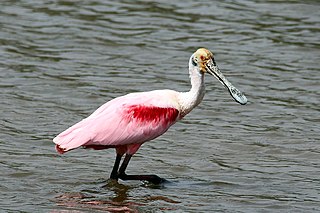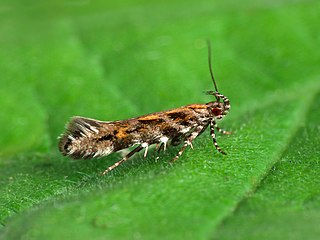Related Research Articles

The roseate tern is a tern in the family Laridae. The genus name Sterna is derived from Old English "stearn", "tern", and the specific dougallii refers to Scottish physician and collector Dr Peter McDougall (1777–1814). "Roseate" refers to the bird's pink breast in breeding plumage.

The roseate spoonbill is a gregarious wading bird of the ibis and spoonbill family, Threskiornithidae. It is a resident breeder in South America mostly east of the Andes, and in coastal regions of the Caribbean, Central America, Mexico, the Gulf Coast of the United States, and from central Florida's Atlantic coast at Merritt Island National Wildlife Refuge, adjoined with NASA Kennedy Space Center at least as far north as South Carolina's Myrtle Beach.

Aristotelia is a genus of moths in the family Gelechiidae. Well-known species are food plant specialists, and diverse hosts are used - Salicaceae, Solanaceae, Rosaceae, Fagaceae, Fabaceae, Asteraceae.

The Elizabeth A. Morton National Wildlife Refuge is a 187-acre (76 ha) National Wildlife Refuge in Noyack, New York. Much of the refuge is situated on a peninsula surrounded by Noyack and Little Peconic bays. The refuge is managed by the United States Fish and Wildlife Service as part of the Long Island National Wildlife Refuge Complex.

Aristotelia roseosuffusella, the pink-washed aristotelia, clover aristotelia moth or garden webworm, is a moth in the family Gelechiidae. It is found in North America, including Alabama, Georgia, Illinois, Kentucky, Maryland, Massachusetts, Michigan, New Jersey, Oklahoma, Ontario, South Carolina, Tennessee and Virginia. The species was first described by James Brackenridge Clemens in 1860.

Aristotelia ericinella is a moth of the family Gelechiidae. It is found in most of Europe, except most of the Balkan Peninsula.
Aristotelia brizella is a moth of the family Gelechiidae. It is found in most of Europe, except Ireland, Switzerland and most of the Balkan Peninsula. Outside of Europe, it is found in North Africa and the Near East.
Pseudotelphusa palliderosacella is a moth of the family Gelechiidae. It is found in North America, where it has been recorded from Alabama, Illinois, Kentucky, Maine, Maryland, Ohio, Oklahoma, Texas and West Virginia.
Gelechia maculatusella is a moth of the family Gelechiidae. It is found in North America, where it has been recorded from California.
Aristotelia aquosa is a moth of the family Gelechiidae. It was described by Edward Meyrick in 1925. It is found in North America, where it has been recorded from Kentucky.
Aristotelia dryonota is a moth of the family Gelechiidae. It was described by Edward Meyrick in 1926. It is found in South Africa, where it has been recorded from the Western Cape.
Aristotelia adceanotha is a moth of the family Gelechiidae. It was described by Keifer in 1935. It is found in North America, where it has been recorded from California and Washington.
Aristotelia bifasciella is a moth of the family Gelechiidae. It was described by August Busck in 1903. It is found in North America, where it has been recorded from California, Arizona and Utah.

Aristotelia elegantella is a moth of the family Gelechiidae. It was described by Vactor Tousey Chambers in 1874. It is found in North America, where it has been recorded from Arizona, California, Colorado, Illinois, Indiana, Iowa, Kansas, Kentucky, Louisiana, Mississippi, New Mexico, Ohio, Oklahoma, Ontario, Texas and Utah.
Aristotelia ivae is a moth of the family Gelechiidae. It was described by August Busck in 1900. It is found in North America, where it has been recorded from Florida and Georgia.
Aristotelia lespedezae is a moth of the family Gelechiidae. It was described by Annette Frances Braun in 1930. It is found in North America, where it has been recorded from Alabama, Florida, Kentucky, Maine, North Carolina, Ohio, Oklahoma and West Virginia.
Aristotelia lindanella is a moth of the family Gelechiidae. It was described by William Barnes and August Busck in 1920. It is found in North America, where it has been recorded from California.
Aristotelia perplexa is a moth of the family Gelechiidae. It was described by Clarke in 1951. It is found in Argentina.

Aristotelia rubidella is a moth of the family Gelechiidae. It was described by James Brackenridge Clemens in 1860. It is found in North America, where it has been recorded from Alabama, Alberta, Arkansas, British Columbia, California, Florida, Georgia, Illinois, Indiana, Iowa, Kentucky, Louisiana, Maine, Manitoba, Maryland, Massachusetts, Michigan, Mississippi, New Jersey, North Carolina, Ohio, Oklahoma, Ontario, Quebec, South Carolina, Tennessee, Texas, Virginia, Washington, West Virginia and Wisconsin.
Aristotelia salicifungiella is a moth of the family Gelechiidae. It was described by James Brackenridge Clemens in 1865. It is found in North America, where it has been recorded from California, Illinois, Ohio and Ontario.
References
| This article on a moth of the genus Aristotelia is a stub. You can help Wikipedia by expanding it. |